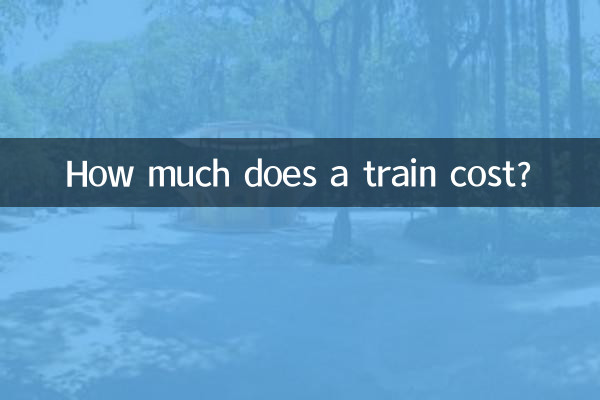How much does a train cost? ——Revealing the secrets of train cost and recent hot topics
Recently, with the rapid development of global transportation infrastructure, the construction and operating costs of trains, as an important means of transportation, have become a hot topic of public concern. This article will combine hot topics in the past 10 days to provide you with a detailed analysis of the price structure of a train, and attach a structured data comparison.
1. Basic components of train cost

The price of a train is affected by many factors, including model, technical configuration, manufacturer, etc. Here are the common train types and price ranges:
| Train type | Price range (RMB) | Remarks |
|---|---|---|
| Ordinary passenger train | 20 million-50 million | Suitable for short and medium distance transportation |
| High-speed EMU (such as Fuxing) | 150 million-250 million | Top speed 350 kilometers per hour |
| subway train | 30 million-80 million | Single carriage cost |
| freight train | 10 million-30 million | Loading capacity determines price |
2. Recent hot topics and train-related developments
1.New breakthrough in China's high-speed rail exports: Recently, the Jakarta-Bandung high-speed railway jointly developed by China and Indonesia was officially opened to traffic, marking that China’s high-speed railway technology has once again gained international recognition. The EMU cost of this project is approximately RMB 200 million per train.
2.European rail strikes: Railway strikes broke out in Germany, France and other places due to workers' salary issues, triggering public discussions on train operating costs. Data shows that the cost of a high-speed train in Europe is approximately 300 million euros (approximately RMB 2.3 billion).
3.New energy train research and development progress: Switzerland announced the development of hydrogen-powered trains, with a single train costing about 6 million euros (approximately RMB 46 million), raising concerns about environmentally friendly transportation.
3. Key factors affecting train prices
| factors | degree of influence | Example |
|---|---|---|
| technical complexity | high | Maglev train cost exceeds 500 million per train |
| Material cost | in | Aluminum alloy body is 30% more expensive than steel |
| Customized needs | high | Cost of luxury sightseeing train doubled |
| mass production | low | Large-scale purchasing can reduce costs by 20% |
4. Price comparison of major global train manufacturers
The following is a comparison of quotes from world-renowned train manufacturers in 2023 (unit: RMB/train):
| manufacturer | country | High speed train quotation | Subway train quotation |
|---|---|---|---|
| CRRC | China | 180 million-220 million | 50 million-70 million |
| alstom | france | 250 million-300 million | 80 million-100 million |
| Siemens | germany | 280 million-350 million | 90 million-120 million |
| Kawasaki Heavy Industries | Japan | 230 million-280 million | 60 million-80 million |
5. Hidden costs of train operation
In addition to the acquisition cost, the life cycle costs of a train also include:
| cost type | Average annual cost (RMB) | Proportion |
|---|---|---|
| Maintenance | 3 million-5 million | 15%-20% |
| energy consumption | 2 million-4 million | 10%-15% |
| Labor cost | 5 million-8 million | 25%-30% |
| Line usage fee | 4 million-6 million | 20%-25% |
Conclusion
The price of a train ranges from tens of millions to hundreds of millions of yuan, depending on the technology, purpose and market positioning. As the concept of green transportation becomes more popular, the cost of future trains may change due to the application of new technologies. Investors and the public are advised to pay attention to industry trends to obtain the latest information.

check the details

check the details